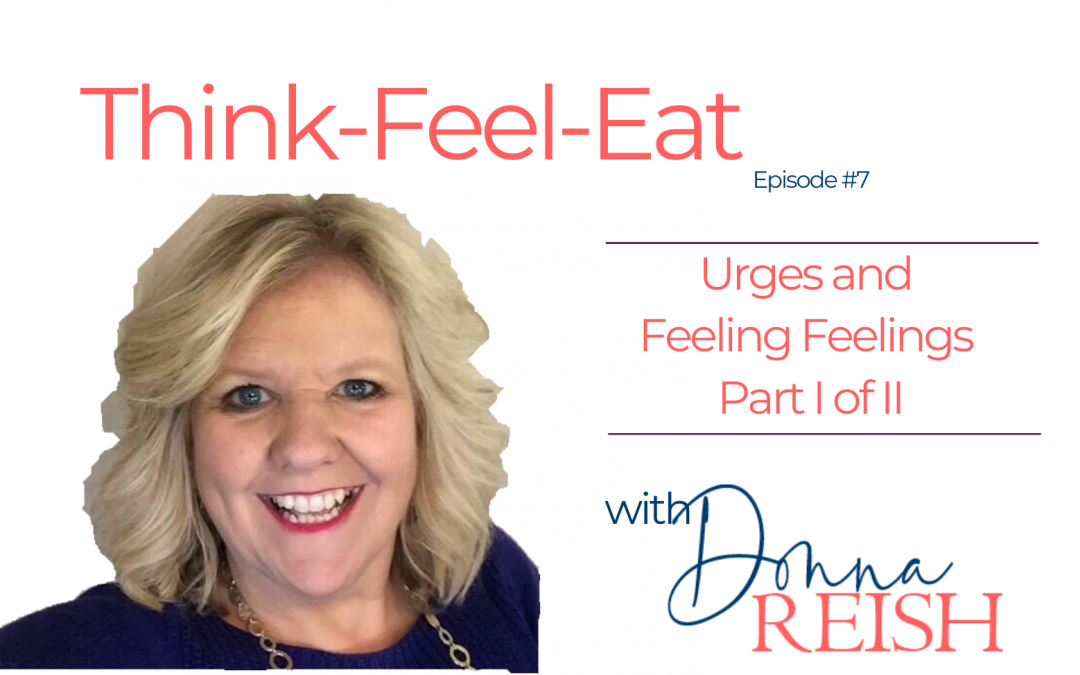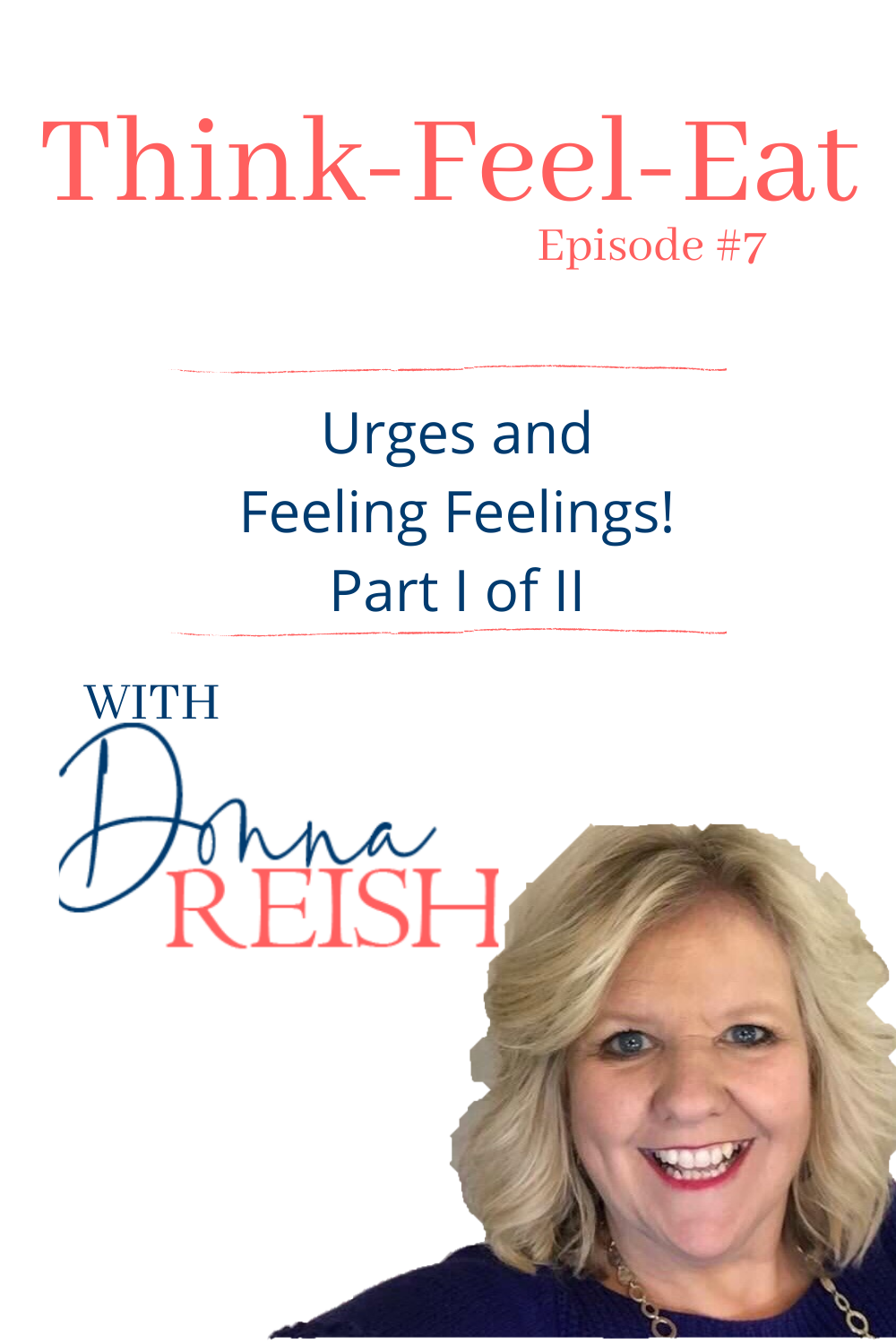
Think-Feel-Eat Episode #7: Urges and Feeling Feelings!
Hi! I’m Donna Reish, IF teacher, weight loss coach, blogger, and half of “The Minus 220 Pound Pair” as my husband and I have lost over 200 pounds together (160 of that in the past couple of years through the Weight Loss Lifestyle habits and strategies I teach!). In this episode, I present Part I of two parts about Urges and Feeling Feelings—really good stuff!
This episode digs into what Urges are. This is super important because if we don’t identify any time we want to do anything off plan or schedule, we are having an urge, we won’t be able to tackle them head on.
Specifically, I teach about how food urges are any of those times that we want to eat something that is
(1) a type that isn’t on our plan for that day;
(2) an amount that isn’t on our plan that day;
(3) a time that isn’t on our plan that day.
This assumes that we have a plan in place (time plan with some form of time restricted eating and food plan with any boundaries we choose—food types, calorie counting, low carb, low fat, counting macros—whatever your plan might be).
(Are you fasting? Free webinar! Intermittentfastingwebinar.com)
Once those are in place, we delve into what urges are and how they feel in our bodies—and what drives them.
Next, I go into one of the biggest factors in handling our urges—deciding ahead of time, using our pre-frontal cortext (rather than our “toddler brain”). We can’t count on willpower or good intentions in the moment of urges. We must plan ahead to overcome them.
Lots more valuable info that will set us up for next week when we look at four responses to urges and how to get to the point where we have fewer urges rather than always trying to battle urges.
Find all of my episodes, outlines, and articles for my two weekly broadcasts:
(1) Weight Loss Lifestyle broadcast (formerly Donna’s Intermittent Fasting Broadcast) and
(2) Think-Feel-Eat broadcast at donnareish.com
Sign up for my free webinar: intermittentfastingwebinar.com
Outline below!
1. Alarm at First Assembly
A. What Are Urges?
1. Any time we have a desire to eat….
a. At a time we didn’t determine we would eat
b. A food that we didn’t plan to eat
c. An amount that we didn’t plan to eat
2. We can’t overcome urges if we don’t have protocols in place that show when something is an urge
a. Are you eating when you’re not scheduled to? (Not really sure…can’t know it’s an urge.)
b. Are you eating a food you’re not scheduled to eat? (Not really sure….can’t know it’s an urge.)
c. Are you eating an amount that is not planned? (Not really sure…can’t know it’s an urge.)
3. Create a Tomorrow Real-for-Me Plan! (more later…)
a. Exact foods
b. Exact amounts
c. Exact times
See more about this in Episode 53 here
B. What Is Overriding Urges?
1. Over-riding our primitive brain is how we overcome urges—and this makes us uncomfortable…very hard to do as our brain wants us to pursue and maintain comfort.
a. Overcoming urges is feeling feelings that we don’t want to feel
b. It is deciding you don’t mind living with the anxiety or the restlessness or the deprivation that you will feel when you don’t give in to urges
2. Buffering with food
a. We buffer our feelings with food when we don’t want to feel them
b. This buffering involves giving in to urges of all kinds (food, pleasures, etc.—all of it feels better than the feelings we don’t want to have)
C. Why is overcoming urges so hard?
1. Urge is an emotion that is intensely driving actions
a. Urges are urgent…urging us to take action immediately
b. Food urges feel urgent
c. Food urges are driven by the need for reward, pleasure, and comfort
2. Nothing wrong with us for having urges…
a. Having desire for pleasure is what we are created to do
b. But overriding it is a process of feeling emotions but not giving in to those emotions
c. The point of junk food is to make us want them
d. (The point of all food is to make us want it)
e. You are a human with a very complex brain that drives urges for us to stay alive—dopamine spike—super important, eat more of it, you need this…fees like life and death
3. We have choices in Think-Feel-Eat…. TFE #6
a. We can make a choice with our pre-frontal cortex rather than our toddler/primitive brain
b. It will feel super powerful but we have to give consent; we don’t have to give in
c. The urge gives us vibrations in our body (feelings)….we have to stop it in the thought…and that usually can’t be done long term unless we do it ahead of time
d. Using willpower, distractions, barriers, etc., can help…but not forever and not as well as using our pre-frontal cortex (deciding ahead of time, creating Thought practices, etc.)—Episodes #60 and #61
e. Using pre frontal cortex ahead of time is better and more long term than fighting against it



























